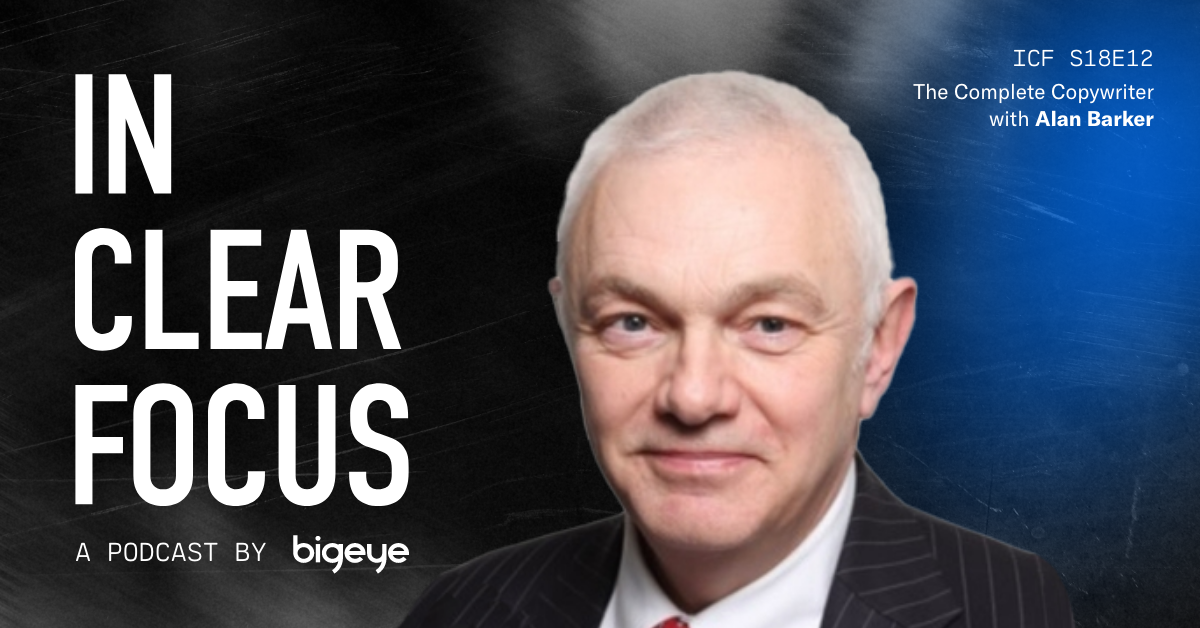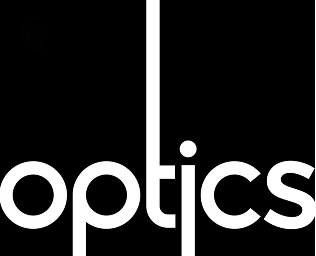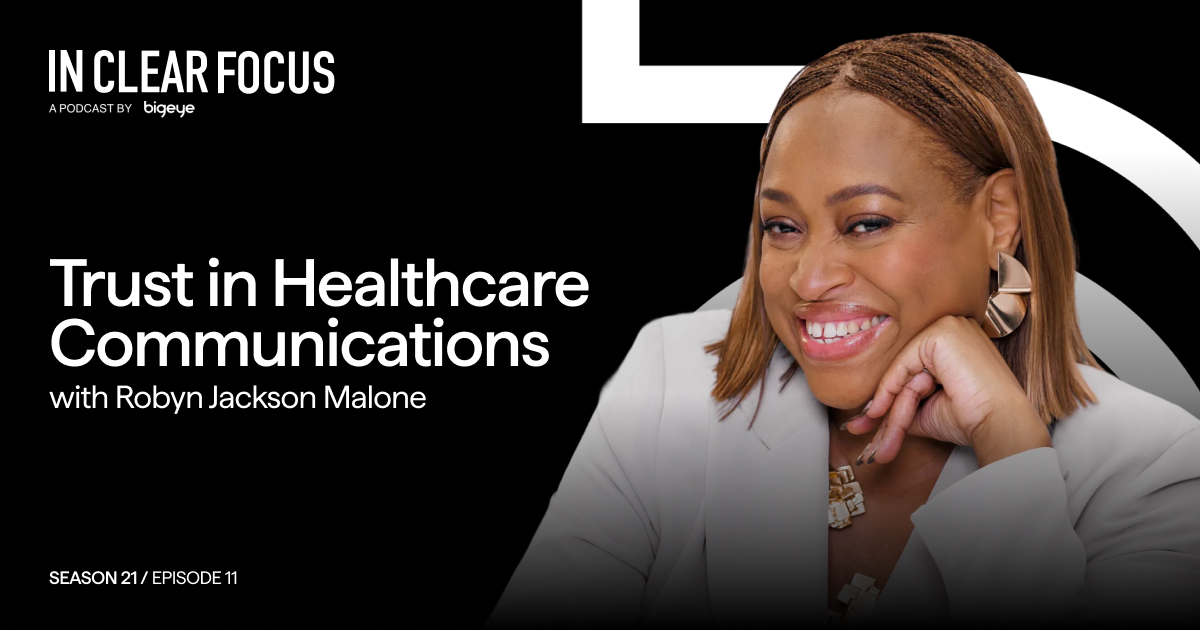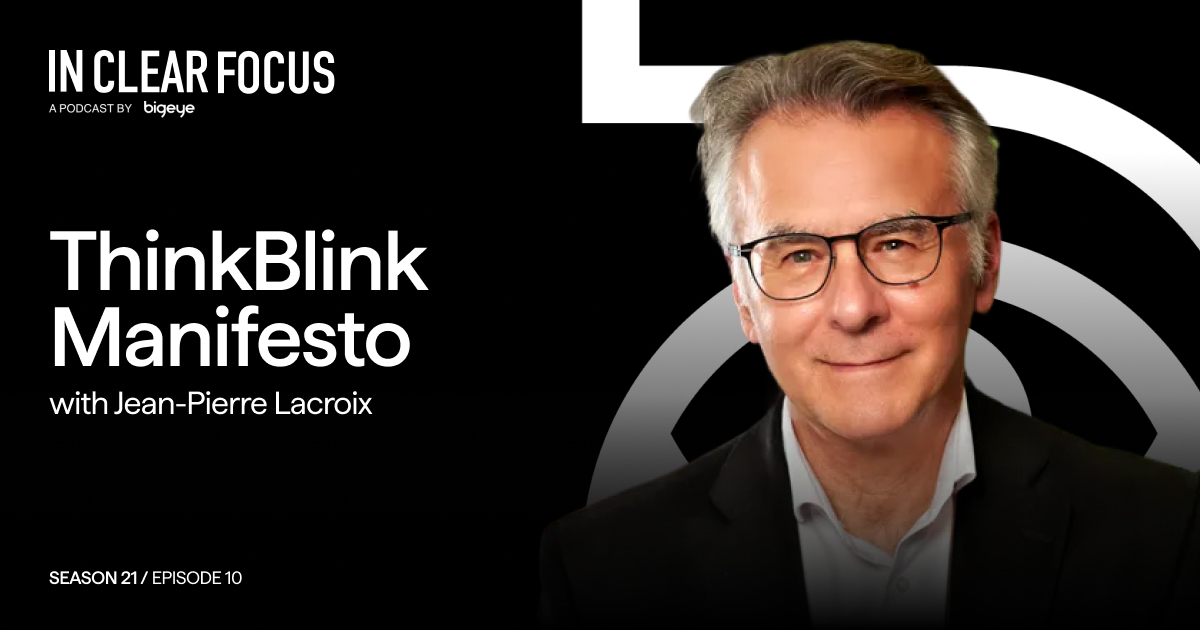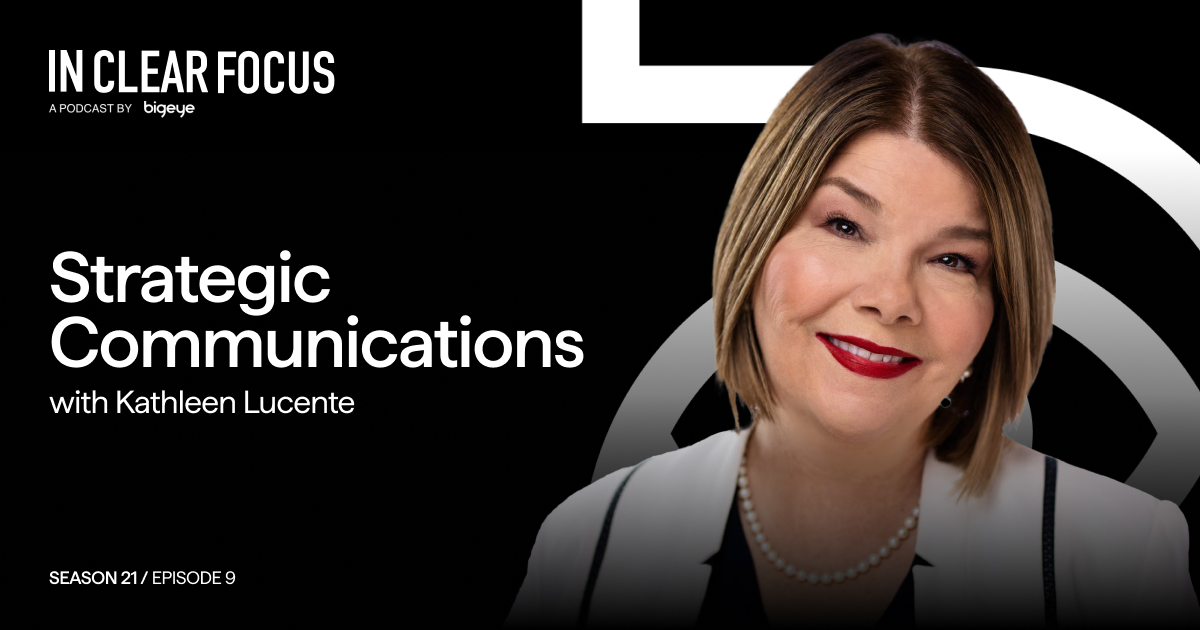IN CLEAR FOCUS: Alan Barker, author of “The Complete Copywriter,” explores the evolving craft of copywriting. Alan shares four core competencies: curiosity, mental mobility, design thinking, and objectivity. He distinguishes between copy, which sells, and content, which informs. He discusses managing creative risk and emphasizes customer-focused conversations over interruption marketing. Hear why human imagination gives copywriters an edge over AI in crafting compelling marketing narratives.
Episode Transcript
Adrian Tennant: Coming up in this episode of IN CLEAR FOCUS:
Alan Barker: Unless we use it very carefully, AI produces copy that tends to be very generalized because AI is always working from stuff that it has learnt in the past, it can’t see into the future. We, as human beings, can see into the future. We can imagine the future.
Adrian Tennant: You’re listening to IN CLEAR FOCUS, fresh perspectives on marketing and advertising, produced weekly by Bigeye, a strategy-led full-service creative agency growing brands for clients globally. Hello, I’m your host, Adrian Tennant, Chief Strategy Officer. Thank you for joining us. Effective copywriting can transform a simple message into a compelling narrative that captures attention, builds trust, and drives action. Yet, as marketing channels multiply and audience attention spans shrink, the art of crafting impactful copy has never been more challenging or more critical. Our guest today is an expert in helping professionals master the nuanced craft of copywriting. Alan Barker is the Managing Director of Kairos Training Limited, a specialist consultancy dedicated to developing creativity and communication skills. He runs the Chartered Institute of Marketing’s Copywriting Masterclass and is the author of multiple books, including his latest, “The Complete Copywriter: The Definitive Guide to Marketing with Words,” published by Kogan Page, which is our selection for the Bigeye Book Club this month. To discuss the evolving landscape of marketing communication and essential skills for modern copywriters, I’m delighted that Alan is joining us today from Wiltshire in the UK. Alan, welcome to IN CLEAR FOCUS.
Alan Barker: Thank you. Thank you very much for having me.
Adrian Tennant: Well, you’ve had a fascinating career path from acting to training to writing. How did your background in theatre influence your approach to copywriting?
Alan Barker: Yeah, it’s a good question. I thought a lot about how my work as an actor has influenced everything I’ve done since then. It’s 30 years now since I was an actor, both in the theatre and on radio. I think that there are all sorts of skills, actually, which are completely transferable. For example, you have to maintain an audience’s attention. You have to think about the scene that you’re playing, the intention of your character, the way in which you’re helping someone else to tell their story. So all of those things are not unlike the work that a copywriter does, not unlike at all. You’re also having to work, of course, or usually you’re having to work as part of a team of creatives, which again is something that copywriters very often have to do. Whether you’re working in our marketing department or a department agency, you are working with other people and you’re having to adapt your ideas to other people’s ideas. You’re having to find parts of yourself that will help you play someone else when you’re an actor. People tend to think about acting as play acting or pretending. It’s not pretending. It’s finding something in you that works for whatever character you’re playing, if that makes sense. Actually, I think that copywriting is very similar to that. You’re having to find what it is in you that will help you to do the job for someone else. I think of copywriting as applied creativity and acting is very similar. I think there are lots of connections, really.
Adrian Tennant: In your book, you emphasize versatility as a key skill for modern writers. Alan, can you elaborate on why adaptability is so important?
Alan Barker: Yes. Well, the world is changing very fast. We all know that. But you as a copywriter, you have to be prepared to adapt to different situations, different briefs, different client requirements, different expectations, different relationships with customers, with clients who aren’t necessarily the same as the customers and different channels as well, different texts, different technologies. You might find yourself in different business relationships. You might find yourself writing copy for different purposes, for different channels. Versatility is absolutely the name of the game. And of course, I haven’t mentioned AI yet. The whole AI story is moving so fast. I think it’s quite difficult at the moment to see precisely what kind of effect that’s going to have on our work as copywriters. But one thing is becoming clear to me, and that is that on the whole, unless we use it very carefully, AI produces copy that tends to be very generalized. It tends to be rather like lots of other copy that’s been produced in the past. Not surprisingly, because AI is always working from stuff that it has learned in the past. It can’t see into the future. We as human beings can see into the future. we can imagine the future. And that is another important element of versatility that I think we have to bring to our work as copywriters. If we don’t do that, then the copy we produce will be rather like that stuff I’ve seen recently called AI slot. It used to be called zombie copy. I talk about zombie copy in the book. Zombie copy is maybe something slightly different. AI slop is zombie copy that’s been produced by a machine. Maybe that’s even worse. We want to avoid all those things. So versatility is crucial to what we’re doing.
Adrian Tennant: Well, let’s bring it back to human beings. Many people write copy without necessarily identifying themselves as copywriters. Alan, what are the core competencies that you think define a truly effective copywriter?
Alan Barker: Well, I think of copywriting as essentially applied creativity. I use the word “applied” because I think copywriting bears the same relationship to, say, what other people might call creative writing, novel writing, poetry, whatever. It bears the same relationship to that kind of writing that graphic design maybe bears to fine art. It’s creativity applied to a very specific brief, but it is nonetheless a creative endeavor, no question. And we can think of being creative as a process in two stages. So first-stage thinking is the thinking we do when we’re looking at whatever we’re looking at and trying to make sense of it. Second-stage thinking is the thinking we do when we’re trying to make something new out of that to create. I think of the core competencies of copywriting as four competencies, two of which fall into each stage. There are two at the first stage and two at the second stage. The first one is curiosity. People often say to me, “How can I write a copy about something that I find boring?” It’s not an unreasonable question. The answer is to cultivate curiosity. There must be something about this, whatever it is, that has some kind of interest, some kind of fascination. Research your products or your services deeply. Research your organization. Research the brand. Research customers. If you can’t find something interesting about this product, well, find someone who does find this product interesting and ask them, what is it about this product that fascinates you? What do you like about this product? The more questions you ask, the more you exercise your curiosity, the more interesting you will find the brief that you’re having to fulfill. I think it also helps if you’re curious just about stuff in general. If you find life interesting, you find the world interesting. That will help because you need to be able to draw on as much as you possibly can as source material for your work. So curiosity, I think, is one of the core skills in first-stage thinking, finding out about the world, finding out what you’re looking at. The other core skill at the first stage you could call mental mobility. It’s like versatility, if you like. It’s a similar kind of thing. Copywriters need to be able to think about the same thing in different ways. You’ll be producing lots of different kinds of copy or content. You’ll be working for multiple clients. You’ll need to switch points of view. You might need to do that very fast. The most obvious way that we exercise mental mobility is to look at something from someone else’s point of view. And you could do that in quite an extreme way. Instead of thinking about how your customer looks at it, this washing machine or whatever it is, think about how an astronaut would look at it, or a Buddhist monk, or a surfer in Australia or something. That kind of mental mobility will help you to look at things in different ways. Mental mobility is also about making connections between different things. So there is a creative technique called force fitting, where you just take two ideas and force a connection between them. There are random word generators, for example, out there on the web that you could use. Take your brief, generate a word at random with a random word generator, and just see what kind of connections come up. You never know. Something interesting might happen. So curiosity and mental mobility seem to me to be the two core competencies at the first stage of the process. The second stage, what we’re trying to do is make something of the ideas that we generated. And that something that we create has to be something that someone will pay for, a client or whatever, something that will work, something that will do the job. So it’s no good just having crazy, fantastical ideas. Those ideas have to be applied. They have to work in the real world. So the two competencies at the second stage, I think, seems to me. The first one is what I would call design thinking. I’m not particularly thinking of design thinking in the way that more strategic thinkers in the business world use the phrase, although it’s very similar. I’m thinking simply of the idea that in order to create a good piece of copy, you need to structure it, you need to plan it. There was a copywriter called Eugene Schwartz, who’s often hailed as one of the best copywriters around. He said, “You don’t write copy, you assemble it. You’re working with a series of building blocks. You’re putting the building blocks together into certain structures.” And he said, “You’re building a little city of desire for your person to come and live in.” It’s a great idea, isn’t it? And I’m very hot on this idea of structure. Structures suggest, as he says in The Tall City, it suggests buildings or something, something three-dimensional that you can walk into. It’s not just a sort of beginning, middle, and end. There are lots of different structures that we can use to make our copy effective. And design thinking is all about knowing something about those structures and being able to apply them well. The very simplest kind of structure can be incredibly effective, a simple problem-agitate-solution kind of structure, which takes your reader on a little tiny journey. It is the kind of core of a narrative structure. Something as simple as that in a social media post or something can be extremely effective. Then again, another kind of structure that I’m very keen on in a completely different context is the idea of saying something and then supporting it. Say it first and then support it. That’s utterly different. to the structure of problem-agitate solution. It’s not a linear structure, it’s not a narrative, it’s something else. So there are these different kinds of designs, different structures, and your reader will respond to those structures depending on where they find the copy and how they encounter it in the book. The final competence is objectivity, which means testing your work in the real world. Without objectivity, you might write copy that doesn’t meet the brief, doesn’t address your reader’s needs, doesn’t get the sale, or whatever it is you’re trying to do. That’s another thing that I think is really important about copywriting these days. It’s not just about selling. So objectivity is about making sure that your copy meets the brief, but it’s also about understanding how language works in a very objective way. It’s about knowing your grammar, knowing your punctuation, knowing how stylistics work, knowing the effects of different kinds of words in your copy, how punctuation can affect the rhythm of your copy, all of that stuff, which can be a bit intimidating if you haven’t got too much of a background feel, but You need to know something about how sentences work. You need to know something about grammar and syntax in order to be able to do the job more effectively. You know, you wouldn’t ask a motor mechanic to start fiddling with your engine if they didn’t know how the engine works. That aspect of objectivity, I think, is really important. Just one last thing about objectivity, because we exercise objectivity when we’re editing and editing is a crucial part of copywriting tasks. People often ask me, what’s the best way to edit? My first answer is, you have to edit. You can’t get it right first time. So don’t even begin to dream that you can. Editing is fundamental to the creative process. You can take a break before you edit. You can ask someone else to read your copy out aloud. I think that’s a really powerful way to check how well your copy is working. How does it sound when they read it out aloud? Not when you read it, but when someone reads it who hasn’t read it before. If they stumble somewhere, that will tell you that you need to change. If they feel good, if they think it sounds good when they finish reading it, then you’ve probably got a pretty good piece of copy there. So take a break, ask someone else to read it aloud, and then test it. Put it into the world and see how it works. A-B testing is your ultimate test to see how the real readers in the real world are responding to your copy. So, four core competencies. Curiosity, mental mobility, first-stage thinking, design thinking, objectivity, second-stage thinking. We never perfect any of them. They’re all life skills. Have those in your back pocket and work at them one at a time, and see how you get on.
Adrian Tennant: Let’s take a short break. We’ll be right back after this message.
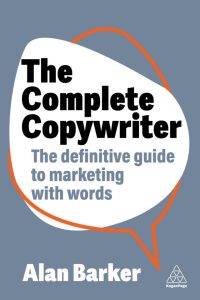 | Alan Barker: Hello, I’m Alan Barker, the author of “The Complete Copywriter: The Definitive Guide to Marketing with Words,” published by Kogan Page. I’ll show you how to exercise your creativity, generate powerful ideas, maintain reader attention, and bring your copy to life. You’ll also learn how to develop a coherent content strategy, how to survive as a copywriter, and how to nurture a satisfying career. Whether you’re a professional writer already, a brand manager, or someone who creates content as part of another kind of job, this book will help you to develop the skills to craft compelling, customer-focused copy. As a listener to IN CLEAR FOCUS, you can save 25 percent on “The Complete Copywriter” when you order directly from Kogan Page. Just enter the exclusive promo code BIGEYE25 at the checkout. Shipping is always complimentary for customers in the US and UK. I hope my book helps you to become a more versatile, effective, and confident copywriter. Thank you! |
Adrian Tennant:
Welcome back. I’m talking with Alan Barker, the author of this month’s Bigeye Book Club selection, “The Complete Copywriter“. Alan, your book mentions two framing competencies, risk-taking and self-motivation. How did these qualities impact a writer’s effectiveness?
Alan Barker: Yeah, they are framing competencies. We’re talking about applied creativity in the real world. We’re talking about a practical craft that has a business and a marketing objective. So we need to think about, yeah, these two things, risk-taking and self-motivation. What’s your attitude to risk when you are doing your work? You might enjoy taking risks, in which case you might be what some people call a “Type T” personality, which puts you in the same category as hang-gliders and mountain climbers and gamblers and daredevils and criminals. So, risk-taking has this kind of edge to it. Now, I would never ever suggest, obviously, as a copywriter, that you would do anything that is illegal or immoral, but there will be times when you’ll be facing clients or colleagues who have probably quite risk-averse expectations, and you’re wanting to try something that’s a bit off the wall, and you might have to negotiate. If your gamble succeeds, you get the raise, or you get the job, or you’ve made your career, or whatever. If it fails, then you might be out on the street. So how are you going to manage the risk? If you don’t take some sort of risk, you’re going to create, you know, zombie copy. You’re going to create copy that’s just like all the other copy that’s out there. Believe me, there is an awful lot of tired, formulated copy out there. If you don’t take the risk, you’re just going to do the same stuff. But if you do take the risk, then you’re going to have to think about the possible consequences. So there are ways of managing the risk. Testing, doing pilots, small-scale campaigns, you know, before you go big. But what you can also do for yourself, inside yourself, is cultivate a certain attitude to risk. Some people call it the optimism bias. The optimism bias is a preconception in your mind that you are more likely to succeed than fail in life. So you can imagine the opposite. A pessimism bias is, “Well, this is never going to work. I’m always going to fail.” None of us want to be there. Finding the optimism bias might be slightly trickier. Assuming that you’re going to be successful at everything you do. Rehearsing success. Then, when you do fail, what happens? Well, you don’t think to yourself, “Well, there we go. I knew it would fail.” You think to yourself, “Well, that’s interesting. Why did that happen? What can I learn from that? How can I do better next time? How can I salvage the situation?” Having that kind of bias in the back of your mind helps you to learn from your mistakes, helps you to do better next time. So managing risk is a really important element here, particularly in commercial fields where for all the talk, there’s a lot of risk-averse culture around. And I’m not just talking about commercial cultures here. You might well be writing copy in the public sector, people who work for local authorities, for governmental institutions, for NGOs and charities, and so on. There’s an awful lot of copywriting going on in those sectors. Those sectors too can be very risk-averse. Finding ways to negotiate that is very important. That brings us to self-motivation. So then think about, well, what is it that’s motivating you to do this work? Is it the money? Is it the recognition? Is it the collaboration with other people? Is it the satisfaction of seeing a great piece of work come together and go out into the world? What makes you feel happy when you’re working? If you’re working on a piece of copy right now, ask the same questions about your reader or your customer, the person who’s going to read this copy. What would make them feel happier? What could they do to make themselves feel happier? How could your copy help to increase their stock of happiness? So, motivating yourself and motivating a reader are complementary skills. Many creative people tend to be very self-motivated. There’s a technical term, and it’s autotelic. Are you an autotelic person? Sounds like something out of Star Trek. To be autotelic means that you do something for its own sake. You don’t do it for the rewards. You don’t do it for the salary. You don’t do it for the trophy. You do it because it matters. And nothing matters but the buzz of doing it. Some people call it being in the zone. Csikszentmihalyi, of course, called it being in the flow state. If you’re in the flow state, then that’s the ultimate in self-motivation. You’re doing it because you have to do it. Because not doing it would be miserable. And when we’re in the flow state, we tend to ignore how others are looking at us. We tend to ignore any thought of reward. We tend to ignore, and this can be tricky, we tend to ignore time. People often get quite irritated with creatives because they just have forgotten the fact that there’s a deadline. You’ve got to do this by a deadline. No, I’m too busy. This is too much fun. Don’t stop me. Got to exercise objectivity, you see. But if you find yourself in the flow state, where this is ultimate level of self-motivation, then you’re probably going to produce something very interesting. Of course, you then have to test it objectively. You have to make sure the structure works. You have to make sure that it’s fitting the brief and all of that. So all the time there’s this tension between what motivates you and what you’ve got to do to meet the brief. That’s okay, that’s part of the job. Without the self-motivation, you’re just going to be a hack.
Adrian Tennant: Alan, there’s often confusion about the difference between copy and content. How do you define these terms?
Alan Barker: Good question. The simple answer to your question is provisionally. So I define them provisionally. I’m not absolutely convinced of the distinction that I’m making here. I’m still exploring it, but it goes something like this. Your reader is either browsing or searching. If they’re online, they’ll either be using a browser or they’ll be using a search engine. If they’re browsing, they’re not particularly interested in anything. Your task is to attract their attention and take them somewhere. If they’re searching, then they are looking for something, and your task is to give it to them as quickly and clearly as possible. So if they’re browsing, they don’t quite know what they want. You’ve got to suggest there might be something here that would be of interest to them, that will be valuable to them, that will be useful to them. And very broadly speaking, that’s what copy does. If they’re searching, then they’re looking for information. They’re looking for more information. They’re looking for details that will help them make a decision. They’re already looking for something. They are searching, right? And that’s what content delivers. The distinction is fuzzy, but it goes something like this: Copy sells and content informs. Copy seeks to convert someone from not buying something to being interested in buying. Content generates traffic. Copy seeks to convince the reader to act now. Content guides the reader towards future action. Copy tends to be shorter. Content tends to be more long-form. Copy tends to address the reader directly. Lots of you. Content usually talks more about a topic. We can also divide copy into, you know, brochures or ads or social media stuff, and content be more like articles, thought leadership pieces, books or booklets, and so on. And the copywriters I meet are increasingly writing both copy and content, and they demand different skills, hence the need once again for versatility.
Adrian Tennant: Right. In the book, you discuss the relationship between those commissioning copy and the copywriters themselves. Alan, what advice would you give to both parties to ensure a successful collaboration?
Alan Barker: Write a good brief. Next question. It’s very hard not to have a brief at all, but I think we often find ourselves walking into the room and a client or a manager says something like, they’ve got a sheaf of papers and they say, “I want you to write some copy for the website. Here’s the product information. It’s all pretty self-explanatory. Just go and do that.” It’s very important not to walk away from that conversation. You need more than that. You need to ask a few questions. You need to note down the answers. You may need to motivate the client or the manager to give you those answers, especially if they’re someone you might call a subject matter expert or a thought leader. They may not quite understand what you’re trying to do. You need to explain that you want to write a copy that works as well for them as possible. You don’t want to waste their time. You don’t want to waste their money. So ask questions like, “What do you want this copy to do? Who’s the reader for this copy? What do we know about them? Can I go and meet them? What’s the benefit we’re talking about here? What do you want the reader to do after reading this copy? Is this copy like anything that we’ve done in the past, or you’ve done in the past? Is there any way you want it to be different? What’s the deadline?” All of those questions will give you useful information. And if you can, then assemble those into a clearly structured brief, which you both sign, then there’s a better chance that you will produce something that will satisfy.
Adrian Tennant: So alignment is key.
Alan Barker: Yes, yes. But alignment with what? That’s the question. I sometimes talk about the curse of the client. The client may think that what you’re trying to do is align with their objectives. But you’re not. What you’re trying to do is align with the customer’s objectives. The client’s customer’s objective.
Adrian Tennant: Right.
Alan Barker: You see what I mean? So some clients are so concerned with their own problems that they ignore the customers. Sales are down, 60 percent of customers are still not paying by direct debit – idiots! Whatever problems are keeping your client awake at night are the ones that your client thinks you, the copywriter, can solve. So you end up with headlines like, um, “Tomorrow’s technology today,” or “The best just got better.” I love those pieces. They’re usually press releases, but say things like, “We’re delighted to announce the appointment of our new head of meaning.” And you think, “Well, whoop-de-doo, who’s interested? Apart from the head of meaning and their colleagues!” You’re not solving your client’s problems. Your customer’s not interested. You’ve got to focus on the customer. And it can be quite difficult to get the client to see that because they might think they can’t quite see the benefit. Yes, it’s all about benefit, but it’s benefit for the customer, not benefit for the client. So that’s why they’ve hired you, because you can provide that mental mobility to think about the customer rather than the client’s problems. Yeah, have a clear brief and make sure you’re not afflicted by the curse of the client.
Adrian Tennant: Alan, what’s the one key takeaway you hope readers will gain from “The Complete Copywriter“?
Alan Barker: It’s the biggest book I’ve ever written, so that’s quite a hard question. I think I would want the reader to take away the idea that copywriting is a conversation. We’re moving from interruption marketing to permission marketing. That doesn’t mean interruption marketing isn’t happening still. Of course it is all over the place. But in the old days, copy was advertising, and it was standing there rather like those market traders. I used to go and watch when I was a kid in Southeast London at the market. I was fascinated by these guys. All guys, of course, I suppose there must’ve been some women. I don’t remember any, it was mainly blokes – men -shouting their wares in the market over here, something really fascinating. And then they would do the whole spiel about, you know, “I’m not asking three pounds. I’m not asking two pounds.” It was a long time ago. You know, “I’ll give you, I’ll give you half a dozen for 50p.” Well, shouting out and attracting attention is interruption marketing. We’re moving beyond that because customers are getting wise to it. They got wise to it ages ago. So we need to move towards what Seth Godin calls permission marketing, which means holding a conversation. How are you going to start that conversation with your reader? Yes, you might need to say, “Over here, something really exciting!” But then you’ve got to do something better than that because your reader’s going to go, “Oh yeah, everyone’s saying that. Go away, I’ve got better things to do.” How are you going to establish an ongoing conversation with your customer? We talk about the customer journey, the customer funnel from awareness through to buying and then retention and finally advocacy and being an influencer and all that stuff. How are you going to keep that conversation going? That’s your task as a copywriter, and that’s complicated, and everything in the book is about that. So, that’s maybe the one thing that I’d like people to take away.
Adrian Tennant: For listeners interested in learning more about your work or the book, where can they find more information?
Alan Barker: Well, about this particular book, of course, you can go to the Kogan Page website, which will give you full details, and that’s where you can also buy the book with a generous 25 percent discount, if you know the code. You can also go to my blog. If you Google “Alan Barker adventures in creativity and communication,” that should bring up my blog fairly high in the ranking. I put articles on there quite frequently, which relate to all my interests, including all this material about copywriting. So you can also find out more about me and my work there. You can also find out about the training courses that I run. There are course outlines on that blog. I might just also mention that I have another book called “How to Improve Your Communication Skills,” which is coming out in its 7th edition in May 2025. And that covers communication not just for writing, but in all sorts of other modes as well, meetings, presentations. The idea of communication as a conversation, which is really, I suppose, one of my core interests, all of that is in my book.
Adrian Tennant: Perfect. Alan, thank you very much for being our guest this week on IN CLEAR FOCUS.
Alan Barker: Thank you. It’s been a great pleasure. Thanks for having me.
Adrian Tennant: Thanks again to my guest this week, Alan Barker, the author of this month’s featured book, “The Complete Copywriter.. As always, you’ll find a complete transcript of our conversation with timestamps and links to the resources we discussed on the IN CLEAR FOCUS page at Bigeyeagency.com. Just select ‘Insights’ from the menu. Thank you for listening to IN CLEAR FOCUS, produced by Bigeye. I’ve been your host, Adrian Tennant. Until next week, goodbye.
TIMESTAMPS
00:00: Introduction to IN CLEAR FOCUS
00:20: The Importance of Effective Copywriting
00:42: Guest Introduction: Alan Barker
01:04: The Influence of Theatre on Copywriting
02:10: Versatility in Modern Copywriting
04:00: Core Competencies of Effective Copywriters
06:02: Curiosity and Mental Mobility
10:03: Design Thinking and Objectivity
14:29: Framing Competencies: Risk-Taking and Self-Motivation
15:51: Defining Copy vs. Content
21:27: Successful Collaboration Between Clients and Copywriters
25:25: Aligning with Customer Objectives
27:05: Key Takeaway from “The Complete Copywriter”
29:04: Where to Find More Information
30:10: Conclusion and Thanks
